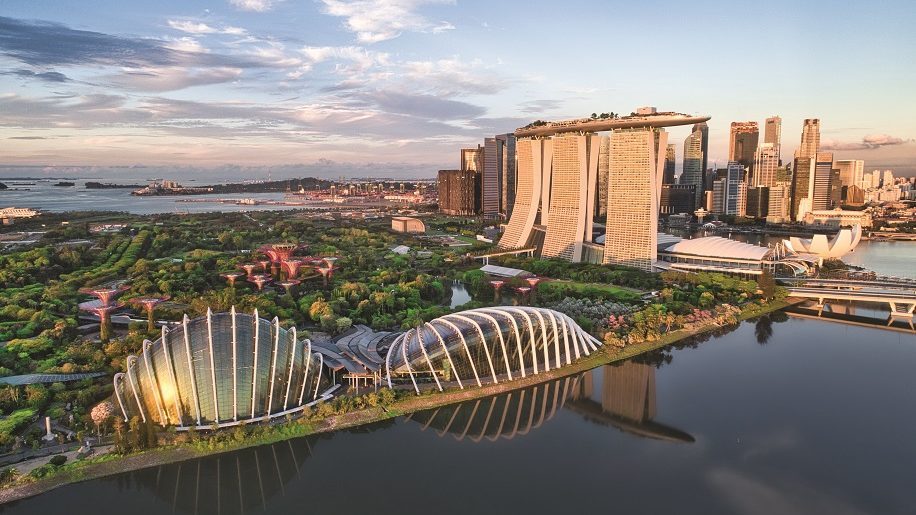
The island state gives new meaning to its moniker, with sustainable efforts blooming across the city.
Locals watched our convoy of vintage Vespa sidecars zip through the roads of Singapore, before we routed towards colourful Haji Lane, with food scents accompanying us along the city’s narrowest alleyway. It was the first time I had experienced the sights of a city while also unwittingly becoming one, with fellow tourists papping photos as we passed.
The ride also gave me a first-hand glimpse of Singapore’s green transition, with glass high-rises draped with canopies of lush foliage and living walls standing out in the urban landscape. I was told that this biophilic vista is set to pollinate further, with Singapore aiming to plant one million more trees and make 80 per cent of its buildings green by 2030. Aside from boosting our adrenaline levels, this themed tour run by social enterprise Singapore Sidecars made for a wonderfully visual introduction to the city-state’s goal to become Asia Pacific’s leading sustainable MICE destination.
Striving for sustainability
One of the main excuses for not behaving sustainably is the ‘out of sight, out of mind’ mantra felt by those not yet experiencing the repercussions of the climate crisis. Singapore does not have this luxury, with 30 per cent of its land less than five metres above sea level. “[Sustainability] is not just another feather that we want to put in our cap. We realise that it is existential,” said Poh Chi Chuan, executive director exhibitions and conferences at Singapore Tourism Board (STB). As a result, the Singapore Green Plan 2030 is set on advancing the national agenda on sustainable development (see greenplan.gov.sg/targets).
While only launched in 2021, I was glad to see that the green agenda had already been fruitful in securing events at the time of my visit in late November. On my second day, I headed to the inaugural Asian edition of Greentech Festival, a Berlin-based event co-founded by former Formula 1 driver Nico Rosberg. For those that have not heard of it, the festival champions green technologies focused on creating a more sustainable future and also had spin-off events in London and New York last year.
The Singapore outpost, however, had the visual backdrop to fit the ethos, with the event taking place in the Flower Field Hall at Gardens by the Bay, the city’s national garden and horticultural attraction. Here a field of LED lights in shades of green cascaded above the audience, while floor-to-ceiling windows provided glimpses of the Flower Dome. Between meetings, we explored the plant kingdom, discovering everything from Mediterranean species to those from South African savannahs and deserts. Such venues “allow delegates to get this little oasis of peace while still doing business,” explained Chuan.
In the evening, we joined locals to recline on the bases of otherworldly Supertrees (or on the ground once the best spots were taken). The free light show illuminated the night sky with twinkling buds oscillating in time and colour to the beat of well-known theme tunes – a modern star-gazing experience. If you find yourself questioning the energy use of such experiences, Gardens by the Bay is underpinned by sustainability. Most of the trees either have photovoltaic cells on their canopies, which harvest solar energy to light up the trees, or are integrated with the conservatories and serve as air exhaust receptacles.

Overcoming challenges
While Singapore has had a resurgence since reopening in April 2022, Chuan told me that it is unable to get back to 2019 levels unless most of the Asian markets reopen. “Business travel is not one where we are self-sufficient, we do need the region to open up,” he explained.
Having witnessed first-hand the disruption across airports in Europe last year due to resources and staffing issues, a steady recovery is probably a better idea, particularly as the majority of visitors travel by air. In the meantime, the airport remains a popular attraction, with tourists arriving early to take in the wondrous Jewel complex adjoined to Terminal 1.
Singapore’s diminutive size, with a total land area of 724.2 sq km, and expensive reputation are often touted as obstacles for planning large events but, from my experience, the former is not an issue. “Compared to many countries in the region, we are a fragment of what they are… but what you get out of that is compactness, accessibility,” Chuan explained. Indeed, Singapore is a major travel hub and getting around the island is easy, thanks to the efficient MRT (Mass Rapid Transit) system. It’s also safe, clean and English is one of its official languages, making it an attractive destination for MICE. “For people that want to leverage the growth of Asia, Singapore is the nexus for that to happen,” Chuan enthused.
Eco hotels
One of the green buildings I witnessed on my arrival in Singapore ended up acting as my accommodation during the trip, allowing me to explore the role played by the hotel industry in the sustainability field.
Pan Pacific Hotels Group is at the forefront of such green innovation. As I stepped into the jungle-like atrium of Parkroyal Collection Marina Bay – one of the largest and tallest in South East Asia – I wondered if I was dreaming (I was jetlagged, after all). Public spaces are draped in lush greenery and I found myself serenaded by songbirds, housed in gilded cages beside nest-like structures where guests congregated.
Fittingly described as a ‘garden in a hotel’, the property is home to over 2,400 plants, trees, shrubs and groundcovers, which help to purify the air. In-room eco features include motion sensors for lights and air con, refillable large-size amenity bottles, filtered water taps and recycling bins. Behind-the-scenes are elements such as the 210 solar panels on the rooftop which generate the electricity for the hotel’s 13 lifts and its lights.
For me, the hotel’s most interesting venture is its 150 sqm urban farm, run by Edible Garden City, which grows over 60 varieties of fruits, vegetables, herbs and edible flowers on one of the terraces. “It’s a big leap of faith for Parkroyal to come to us,” explained a representative from Edible Garden City, the social enterprise aiming to combat Singapore’s issue with food provision and help the city-state meet 30 per cent of its nutritional needs through locally produced food by 2030. As we toured the site in the beaming sunshine, the representative explained that Edible Garden City’s mission statement is simply to get more people to grow plants. “Take 30 to 50 per cent of plots and make edible plants. If you don’t eat it then don’t grow it.” Given Singapore’s lack of land, it’s not a simple task – hence farms in unconventional places.
Parkroyal is doing its bit with this allotment and is reaping the rewards, with 20 per cent of the produce at its F&B venues originating from the farm. I had already enjoyed an hors d’oeuvres of sorts by sampling herbs during the tour but had the full farm-to-fork experience to look forward to at Peppermint, a dining venue adjacent to the terrace. Daily buffets of colourful and mouth-watering seasonal produce are showcased here, with food waste put to good use – beef trimmings are used to make shredded beef ragu, while watermelon rind is added to stir fries. Everything tasted fantastic, and I left feeling incentivised to develop green fingers.
Sustainability does not mean sacrificing the luxury element or aesthetic, with eco-friendly design and operations actually enhancing the experience. The hotel’s sister property, Parkroyal Collection Pickering, also has a host of green features, while renderings of the forthcoming Pan Pacific Orchard give the impression of a vertical oasis with open-air terraces.

Local culture
Singapore feels futuristic, with a growth mindset to match, but no visit is complete without a dive into its past. Our visit was overseen by the ever-smiling tour guide Kristie Phua, whose knowledge was endless – she rattled off facts, anecdotes and answers without breaking a sweat (even in the high humidity).
It was over a comforting bowl of spicy laksa that Kristie gave us the backstory of her Peranakan community. The title, which translates to ‘local born’, refers to people of Chinese and Malay descent and dates back to the 15th century, when Chinese immigrants married local women from the Malay Archipelago. “Peranakan is not about a race but rather a culture,” she explained as we explored Joo Chiat in eastern Singapore, an area brimming with colourful two-storey shophouses selling Peranakan garments and artisanal trinkets.
Kristie also introduced us to her friend, Alvin Yapp, who holds the keys to the history, traditions and lifestyle of Peranakan culture at his house-turned-museum, The Intan. “For fear of losing our identity, we overcompensated,” he explained as we watched our step in his ever-growing treasure trove, which shines with iridescent Mother of Pearl objects and an enormous collection of ladies’ beaded slippers.
Alvin began collecting 40 years ago, motivated by a desire to learn more about his heritage. His house now holds 5,000 antiques and he hosts regular group tours, which can be tailored depending on guests’ interests – a passion for shoes is clearly a bonus – as well as private dinners. “Business travellers can be a bit jaded but after their visit they tell me that it puts things into perspective and explains why they do what they do,” he said. Connecting with locals and the culture of a destination is, after all, often the most rewarding part of a work trip. “[Collecting] is a poor investment but the memories that I’ve created, the smiles I’ve had, the people I’ve met is the best investment,” he added, before showcasing his musical talent at the piano, sandwiched between antiques.
As we drove to the airport on our final day, Kristie gave us her predictions for the city’s future. “I imagine we will be walking through a jungle, almost like living in Avatar,” she said, with that infectious smile on her face. I left wondering how my sidecar introduction to the city will look by 2030. If all goes well, perhaps visitors will ride in electric-powered vehicles, navigating a contemporary Hanging Gardens of Babylon.

Planning sustainable events in Singapore
Singapore Tourism Board and Singapore Association of Convention and Exhibition Organisers and Suppliers (SACEOS) released a MICE Sustainability Roadmap in December, 2022 with three targets:
- Develop a set of sustainability standards by 2023, with the aim for these to be internationally recognised by 2024.
- Ensure all six purpose-built MICE venues and 80 per cent of SACEOS members obtain internationally or nationally recognised sustainability certification by 2025.
- Track waste and carbon emissions by 2023.













